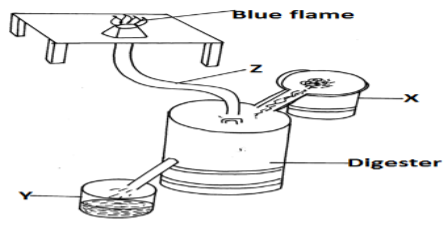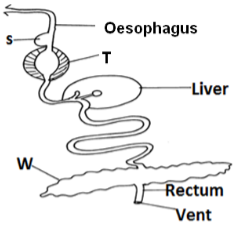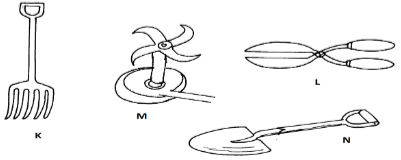- This paper consists of THREE Sections A, B and C.
- Answer all questions in Section A and B.
- Answer any two questions in Section C in the spaces provided.
SECTION A – (30 Marks)
Answer all the questions in this section in the spaces provided.
-
- Differentiate between a parasite and a pathogen. (1 mk)
- Name two categories of parasite in livestock. (1 mk)
- State three factors that stimulate milk let-down in dairy cows. (3 mks)
- Name two conditions which pre-dispose foot-rot in sheep. (2 mrks)
- Name four causes of stress in layers. (2 mks)
- Give two factors considered when siting a calf pen. (2 mks)
- State four factors considered when selecting an implement for primary cultivation. (2 mks)
- State four functions of vitamin in livestock. (2 mks)
- Give two factors that may lead to conception failure after service in heifers. (2 mks)
- Give two uses of litter in a poultry house. (2 mks)
- State two functions of ventilation in a pig house. (2 mks)
- State four reasons for maintaining livestock healthy. (2 mks)
- State three harmful effects of ticks on livestock. (11/2 mks)
- Apart from sharpening blades and lubricating, State three other maintenance practices that should be carried out on a rotary mower. (1½ mks)
- Give two adjustments that should be carried out for proper operations of a disc harrow. (2 mks)
- Give four uses of harrow on the farm. (2 mks)
SECTION B – (20 Marks)
Answer all the questions in this section in the spaces provided.
- The diagram below is a biogas digester.
- Name the parts labeled X and Z. (2mks)
- Name two inputs periodically channeled through X. (2mks)
- Name the use to which material Y is put. (1mk)
- Name two uses of biogas on the farm. (1mk)
- Below is the diagram of a digestive system, use it to answer the question that follows.
- Which farm animal has a digestive system similar to the above system. (1mk)
- Name the parts labeled S, T and W. (3mks)
- Explain the work of the parts S and T. (2mks)
- Study the diagrams below and answer the questions that follow.
- Identify the tools K, L, M and N. (2mks)
- Give the use of K and L. (2mks)
- The diagram below illustrates a breeding management practice.
- Identify the practice. (1mk)
- Outline three reasons for carrying out this practice. (3mks)
- Name three internal parasites in livestock. (3mks)
SECTION C – (40 Marks)
Answer any two questions from this section.
-
- Give four differences between petrol and diesel engine. (8mks)
- Give four functions of a cooling system in an engine. (4mks)
- State eight daily maintenance practices carried out on a tractor. (8mks)
-
- Outline the signs of farrowing in pigs. (5mks)
- Describe the management practices carried out on piglets immediately after birth. (5mks)
- Describe the management practices carried out on a grower from 9 weeks old to the point of laying (10mks)
-
- Name and describe the features of an ideal calf pen. (8mks)
- Discuss pneumonia in calves under the following sub-heading.
- Predisposing factors. (3mks)
- Symptoms. (5mks)
- Control measures. (3mks)
MARKING SCHEME
SECTION A
-
- Differentiate between a parasite and a pathogen. (1 mrk)
- A pathogen is a disease causing organism while a parasite is a living organism which depends on others for food and shelter. (1mk)
- Name two categories of parasite in livestock.
- External/ Ectoparasites
- Internal/ Endoparasites (2x ½ = 1mk)
- Differentiate between a parasite and a pathogen. (1 mrk)
- State three factors that stimulate milk let-down in dairy cows. (3 mrks)
- Presence of calf
- Washing udder with warm water
- Familiar noises or whistling.
- Provision of food during milking
- Restraint of the animal in parlour for milking (3 x 1 = 3mks)
- Name two conditions which pre-dispose foot-rot in sheep. (2 mrks)
- Wet and muddy conditions
- Overgrown hooves
- Physical injuries on foot (2 x 1 = 2mks)
- Name four causes of stress in layers. (2 mrks)
- Introduction of new birds in the house
- Overcrowding
- Presence of strangers
- Too much handling practices
- Too high or too low temperatures
- Poor ventilation
- Parasites attack
- Lack of enough food and water (4 x ½ = 2mks)
- Give two factors considered when siting a calf pen. (2 mrks)
- Proximity to the milking shed
- Drainage (2 x 1 = 2mks)
- State four factors considered when selecting an implement for primary cultivation. (2 mrks)
- Type of crop to be established
- Source of power availableSize of land
- Soil type or hardness of soil
- Cost of using the implement
- Topography
- Vegetation cover
- Skill of operating the implements (4 x ½ = 2mks)
- State four functions of vitamin in livestock. (2 mrks)
- Help in blood clotting
- Act as organic catalyst
- Prevent diseases in livestock
- Help in born formation
- Help in muscular activities (4 x ½ = 2mks)
- Give two factors that may lead to conception failure after service in heifers. (2 mrks)
- Poor timing of service
- Poor nutrition
- Infertility (heifer/bull) (2 x1 = 2mks)
- Give two uses of litter in a poultry house. (2 mrks)
- Keeps birds busy scratching, hence reduce cannibalism
- Gives comfort and warmth to the birds
- Helps in drying droppings (2 x 1 = 2mks)
- State two functions of ventilation in a pig house. (2 mrks)
- Allows efficient air circulation
- Moderates/ regulates temperatures
- Prevents inside of house from becoming humid (2 x 1 = 2mks)
- State four reasons for maintaining livestock healthy. (2 mrks)
- Improves growth rate
- Increases livestock productive life
- Produces high quality produce/ safe produce
- Maintains high productivity
- Reduces spread of parasites and diseases
- Breeds regularly
- Reduces cost of production/ improves profits (4 x ½ = 2mks)
- State three harmful effect of ticks on livestock. (11/2 mrks)
- Cause irritation/ discomfort
- Transmit disease pathogens
- Damage skin/hide
- Suck blood causing anaemia (3 x ½ = 1 ½ mks)
- Apart from sharpening blades and lubricating, State three other maintenance practices that should be carried out on a rotary mower. (1½ mrks)
- Clean the mower after use
- Replace/repair worn out guards and blades
- Paint surface when necessary
- Store in a cool dry place/ put under shed (3 x ½ = 1 ½ mks)
- Give two adjustments that should be carried out for proper operations of a disc harrow.
- Space of the discs
- Angle of gang of discs to the direction of pull
- Depth control by use of hydraulic force (2 x 1 = 2mks)
- Give four uses of harrow on the farm. (2 mrks)
- To level the seedbed
- To break soil clods
- Stir the soil and destroy weeds
- Burrying trush (4 x ½ = 2mks)
SECTION B – (20 Marks)
- The diagram below is a biogas digester.
- Name the parts labeled X and Z. (2mks)
- X – Mixing chamber
- Z – Gas pipe (1x2 = 2mks)
- Name two inputs periodically channeled through X. (2mks)
- Dung/ animal wastes
- Water (1x2 = 2mks)
- Name the use to which material Y is put. (1mk)
- As fertilizer / manure
- To enrich the soil (1x1 = 1mk)
- Name two uses of biogas on the farm. (1mk)
- Domestic cooking /heating
- Lighting (2x1/2 = 1mk)
- Name the parts labeled X and Z. (2mks)
-
- Which farm animal has a digestive system similar to the above system. (1mk)
- Poultry/ chicken (1mk)
- Name the parts labeled S, T and W. (3mks)
- S - Crop
- T – Gizzard
- W – Caecum
- Explain the work of the parts S and T. (2mks)
- S - Store food temporarily and moisten food
- T - Grinding of food with help of sliding movement of tough/ thick muscle sand presence of girt
- Which farm animal has a digestive system similar to the above system. (1mk)
-
- Identify the tools K, L, M and N. (2mks)
- K - Garden/ manure fork
- L - Prunning shear
- M - Sprinkler
- N - Spade
- Give the use of K and L. (2mks)
- K - Collecting manure and trash
- L - Trimming hedges and shrubs / fence
- Identify the tools K, L, M and N. (2mks)
-
- Identify the practice. (1mk)
- Raddling
- Outline three reasons for carrying out this practice. (3mks)
- Helps in keeping accurate records and breeding/ indicates which male served with female (ram/ truck/dice
- Detects unserved/ unmated nannies/ewes
- Helps to know which male are infertile (3x1 = 3 mrks)
- Identify the practice. (1mk)
- Name three internal parasites in livestock. (3 mrks)
- Roundworms
- Tapeworms
- Liverflukes
- Hookworms (3x1 = 3 mrks)
SECTION C (40 Marks)
-
- Give four differences between petrol and diesel engine. (8 mrks)
(4x2 = 8 mrks)Petrol engine Diesel engine ✓ It has a carburetor ✓ Fuel is ignited by an electric spark✓ It produces less smoke✓ It is light in weight✓ Air and fuel mixture are mixed in the carburetor✓ Has an injector pump ✓ Fuel is ignited by compression of air and fuel mixture✓ It produces a lot of smoke✓ It is relatively heavy in weight✓Air and fuel mixture are mixed within the cylinder - Give four functions of a cooling system in an engine. (4 mrks)
- To remove excess heat from the engine
- To maintain the engine operating temperature where it works most efficiently
- To bring the engine up to the right operating temperature as quickly as possible
- To prevent the engine from overheating (4x1 = 4 mrks)
- State eight daily maintenance practices carried out on a tractor. (8 mrks)
- Check the engine oil by use of a dip stick and if low it should be added.
- Check fuel level before days work and add if necessary.
- Inspect the water level in the radiator and top up if necessary.
- Check the level of electrolyte in the battery and top up with distilled water if low.
- Brake fluid should be checked and maintained at the recommended level.
- Check the fan belt tension and adjust appropriately
- Large sediment in the sediment bowl should be removed.
- Loose nuts and bolts should be tightened every day. (8x1 = 8 mrks)
- Give four differences between petrol and diesel engine. (8 mrks)
-
- Outline the signs of furrowing in pigs. (5 mrks)
- Sow becomes restless
- Enlargement of the vulva
- Muscle on each side of the tail slackness
- Loss of appetite
- Udder and teat becomes enlarged
- Sow collect bedding materials at one corner
- 24 hours before furrowing there is milk present in the teat (5x1 = 5 mrks)
- Describe the management practices carried out on piglets immediately after birth. (5 mrks)
- Check and ensure piglet is breathing
- Keep the piglet in a warm place
- Ensure the piglet suckle the mother within first 6 – 12 hours in order to get colostrum which is rich in nutrients.
- Disinfect the naval cord to avoid naval illness or any possible infections
- Ensure there is removal of the after birth to prevent the sow from eating the piglet.
- Assist the piglet to suckle
- Provide iron injection to avoid anaemia
- Weigh the piglet and keep records (5x1 = 5 mrks)
- Describe the management practices carried out on a grower from 9 weeks old to the point of lay. (10 mrks)
- Growers are the pullets and are the age of 9-20 weeks. No heat is provided at this period.
- Sufficient space per birds as the floor should be adequate.
- Provide dry litter to depth of 20-40 cm deep
- Ensure there is sufficient feeding and watering troughs placed in strategic point.
- Provide clean water which should be given adlibdum
- At this stage birds are fed on growers mash.
- Ensure hygienic conditions are maintained in the structure.
- Fresh feed must be provided
- Disease control through vaccination should be carried out.
- Check external parasite and dust birds with appropriate pesticide.
- Check vices among birds.
- Roost and perches should be installed into the house for the birds to perch while resting.
- Introduce oyster shell when birds are at the age of 16 weeks.
- Provide green vegetables by hanging them in the house and provide grit to provide grit to keep birds busy.
- At age of 16 weeks introduce layers mash and mix with growers mash.
- Cull weak birds
- Control external parasites
- Debeak perpetual cannibals (10x1 = 10 mrks)
- Outline the signs of furrowing in pigs. (5 mrks)
-
- Name and describe the features of an ideal calf pen. (8 mrks)
- Concrete/ raised slanted floor – easy to maintain cleanliness.
- Dry litter / Bedding – maintain warmth
- Proper lighting – should have good supply of natural light / sunlight.
- Proper drainage – facilitate free flow of urine and water to avoid dampness
- Draught free - the structure should stop strong winds from blowing into the calf pen.
- Proper ventilation – structure should allow for fresh air circulation.
- Security – should be strong enough to keep away intruders and wild animals (4x2 = 8 mrks)
- Discuss pneumonia in calves under the following sub-heading.
- Predisposing factors. (3 mrks)
- Overcrowding of calves in the pen.
- Dampness / chilliness in the pen
- Poor ventilation
- Young age
- Effect of diarrhea and other illness (3x1 = 3 mrks)
- Symptoms. (6 mrks)
- Dullness and reluctant to move
- Loss of appetite
- Animal develops rough hair coat
- Animal becomes emaciated
- Rapid breathing
- Fluctuation in body temperature
- Nasal mucous discharge (6x1 = 5 mrks)
- Control measures. (3 mrks)
- Young animals should be kept in warm pens
- Proper sanitation should be maintained.
- Early cases should be treated using antibiotics
- Isolate affected animals for proper nursing in a warm pen (3x1 = 3 mrks)
- Predisposing factors. (3 mrks)
- Name and describe the features of an ideal calf pen. (8 mrks)
Download Agriculture Paper 2 Questions and Answers - Form 4 Term 3 Opener Exams 2023.
Tap Here to Download for 50/-
Get on WhatsApp for 50/-
Why download?
- ✔ To read offline at any time.
- ✔ To Print at your convenience
- ✔ Share Easily with Friends / Students





